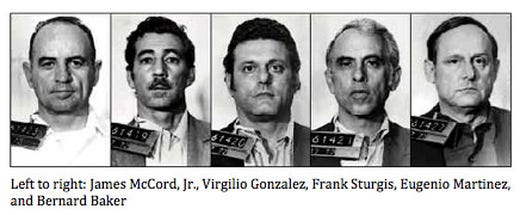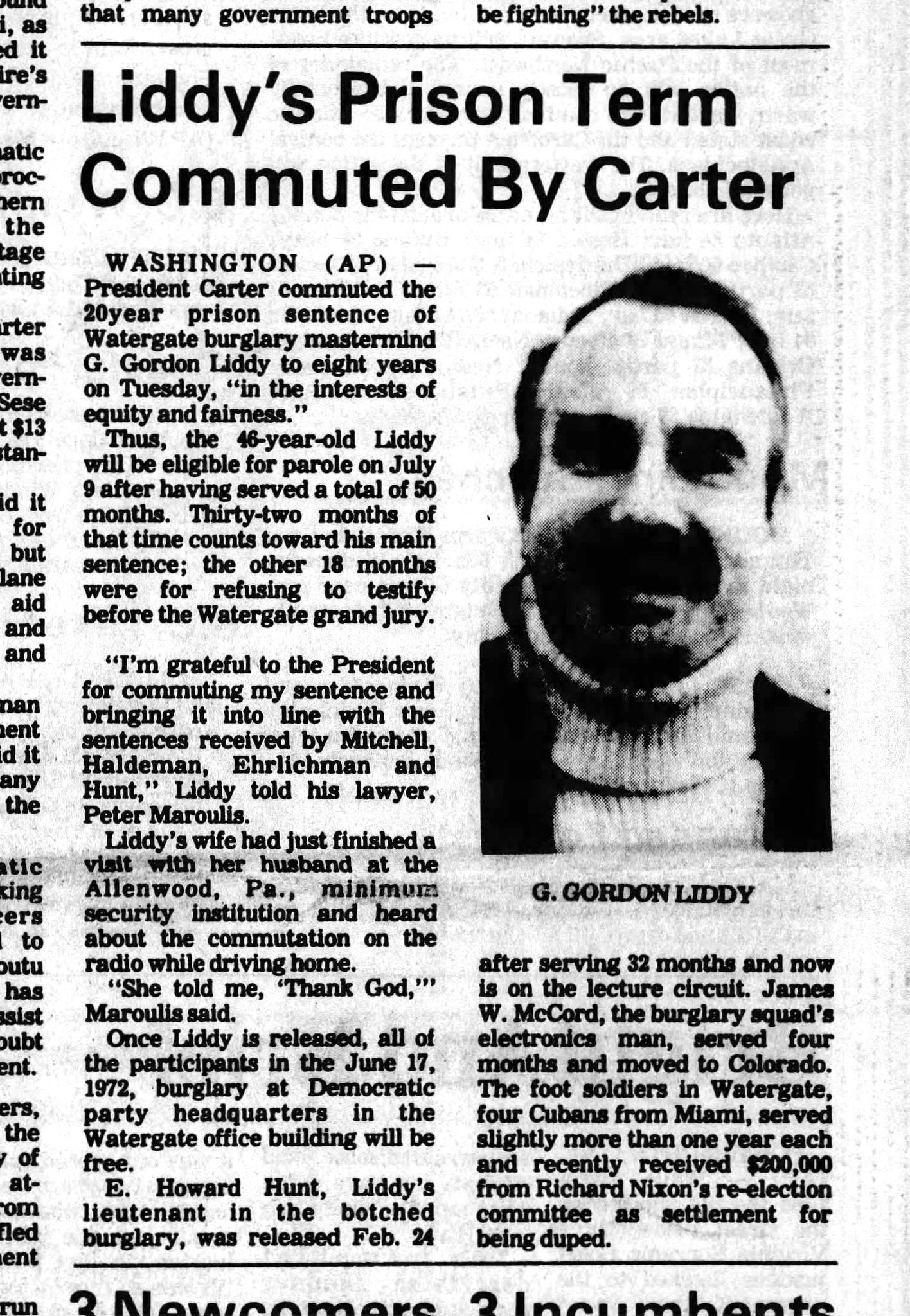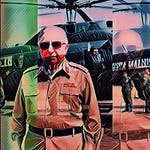Time Stamps:
Dean Recruits Liddy (Skit) (0:00)
What Happened at the Watergate Complex? (2:38)
Meet the “Ex-CIA” Burglars (4:48)
Was Liddy a Dupe? (7:45)
An Eye For the Dirt (10:25)
What Did Dean Know, and When Did He Know It? (13:53)
The following is based on revised historical accounts that challenge a widely accepted view of the events surrounding Watergate.
On June 17, 1972, the second of two break-ins at the DNC Headquarters at the Watergate Complex occured.
Most Americans know that President Richard Nixon disgraced himself in a cover-up, and was eventually forced to resign or face impeachment and removal.
But what most of us don't know is what truly motivated the break-in to begin with. Mark Felt, famously known as "Deep Throat," believed it may have been “a White House operation, a CIA operation, or both.”
Meet the Burglars
Known then only by the monikor "Deep Throat" at the time, Felt secretly guided the reporting of Bob Woodward and Carl Bernstein of the Washington Post through their investigation.
This reporting set the standard for modern investigative reporting.
While to be sure it has its value in policing and potentially exposing wrongdoing by the rich and powerful, it's often coupled with bias, sensationalism, and a hidden agenda.
At approximately 2:30 a.m. on June 17, 1972, five men in suits, with rubber gloves, cash, and scores of electronic equipment were arrested. Four of them were Cuban emigres who fled the Castro regime and participated in the failed Bay of Pigs invasion with the CIA.
Here's a real curveball:
Eugenio Rolando Martinez, a Cuban-American burglar, fought the Metropolitan Police for a notebook with a key taped to it, matching the desk of DNC secretary Ida “Maxie” Wells.
The fifth burglar was James McCord, then-director of security for the Committee to Re-Elect the President (CRP, or more crudely, dubbed "CREEP"). McCord was also a recently retired CIA agent, who served as an advisor in the Bay of Pigs invasion.
The same burglars made their way into the Watergate Complex just two weeks ago.
E. Howard Hunt, an ostensibly retired CIA agent (who had falsely retired twice before), was soon identified as a supervisor for the burglary. For some time following this "retirement,” Hunt pushed hard to make his way into the Nixon administration on a part-time basis.
On December 8, 1972, Hunt's wife, Dorothy, was killed in a plane crash. Next to her body was $10,000 in cash. McCord eventually described Dorothy Hunt as a courier for "hush money" to the Senate, a claim met with substantial contention.
Not only was this mysterious event a personal tragedy for Howard Hunt, it also complicated his legal defense. Indeed, Hunt's lawyers would struggle to retain his notebook, which would have been of use in a "CIA defense."
More on that in a bit.
Was Liddy a Dupe?
G. Gordon Liddy, also a supervisor for the break-ins, was the only participant of the seven without a history with the CIA. Previously, Liddy had worked as an FBI agent. He had worked with the Plumbers unit, famous for the break-in of Daniel Ellsberg's psychiatrist's office. Soon after, Liddy joined the CRP by the insistence of John W. Dean, who promised exciting intelligence opportunities and a handsome budget.
Between Liddy's blind loyalty and Dean's blind ambition, the pair were like fire and kerosene. Liddy, who offered to take a bullet in service to his country and the administration he served, made for the perfect dupe, had there been any hidden agenda behind the Watergate affair.
Liddy, who had thought the break-ins were aimed at opposition research and obtaining strategic information from the DNC headquarters, came to terms with the much stronger possibility that he was a dupe for a larger plot after reading Silent Coup by Len Colodny, a powerful, groundbreaking counter to the conventional Watergate narrative.
By involving Liddy, the CIA could concoct a defense that their operation had the blessing of the Nixon administration.
The CIA's charter confines its operations to foreign territory, but the federal courts often gave them leeway domestically if they could demonstrate that their actions were requested in the service of the President. This defense could be bolstered by pointing to the CRP funding and the notebooks that kept records of even the most trivial suggestions by the President and White House personnel.
An Eye For the Dirt
In many historical accounts is the testimony of an ambitious but inexperienced lawyer with an inflated job title by the name of John W. Dean. In fact, John Ehrlichman, formerly the White House Counsel, now Nixon's Chief Domestic Advisor, retained many of the responsibilities traditionally performed by the White House Counsel, now Dean's position.
But most of these accounts fail to provide a sufficient backstory to explain how Dean got himself into the darker forces of the Nixon camp (and as we will find, brought in much of this darkness, himself).
Dean was fired from his first position as a lawyer upon the discovery that he pursued a television license in secret for a client's competitor. He developed a reputation as an idea thief, prompting co-workers to lock away their papers out of fear that Dean would help himself to their contents.
Dean climbed the latter through a series of political connections, demonstrating himself as a shrewd opportunist bent on seeking compromising information on political opponents. Including - perhaps particularly - an interest in sexual dirt on high-profile Democrats.
Maureen Biner, soon to be his wife, had been best friends with Heidi Rikan, who under an alias ran an escort service in Washington DC that attracted the attention of a nosy CIA known for surveillance of prostitutes and their johns.
Remember the key that Eugenio Rolando Martinez had in his possession at the time of his arrest, matching the desk of Ida "Maxie" Wells at the DNC? Allegedly, this desk had, as Mitt Romney may word it, "binders full of women" that Democrats could hook up with for a night of adult entertainment.
Dean was not new to the subject. The last time he attempted any investigation of sexual dirt, he found plenty of it. The only problem was, it also included many Republicans.
What Did Dean Know, and When Did He Know It?
By early June of 1972, neither Hunt nor Liddy saw the benefit of a second break-in at the Watergate complex. While Dean denies ordering the break-in, Howard Hunt and Jeb McGruder have affirmed otherwise. This conclusion was shared by Silent Coup author Len Colodny.
Over the next nine months, Dean professed no knowledge of White House involvement in the break-ins. Far from a bystander in the dark, some believe Dean to be the architect of the cover-up. As the cover-up fell apart, Nixon assigned Dean to write up the details of the break-in. After Dean failed to explain the break-in without incriminating himself, Nixon fired him.
Remember the notebook that kept the operational notes of E. Howard Hunt? Apparently, it was destroyed by John Dean. Dean also advised Hunt to plead guilty, in effect, revoking any Fifth Amendment plea. Between this and the death of his wife, Hunt's hands were tied, and his "CIA defense" would never see the light of day.
Earl Silbert, Jr. was assigned to prosecute the Watergate break-ins. According to Colodny, Silbert believed the aim of Watergate was "embarrassing tapes of a sexual nature" that could be used as political blackmail. However, the prosecution would avoid making any connections to CIA participation, as it would facilitate the CIA defense, which would drastically weaken their case.
As for Dean, he became preoccupied with obtaining immunity once the Watergate cover-up had failed. He was willing to implicate everyone but himself if it bought him time outside of a jail cell.
External Resources:
John Dean’s Watergate Whitewash by James Rosen
BOOK: The Mysteries of Watergate: What Really Happened by John O'Conner
PODCAST: The Mysteries of Watergate by John O'Conner
VIDEO: The Temple Lectures by Geoff Shephard
PODCAST: The Fighter by Red Pilled America

















Share this post